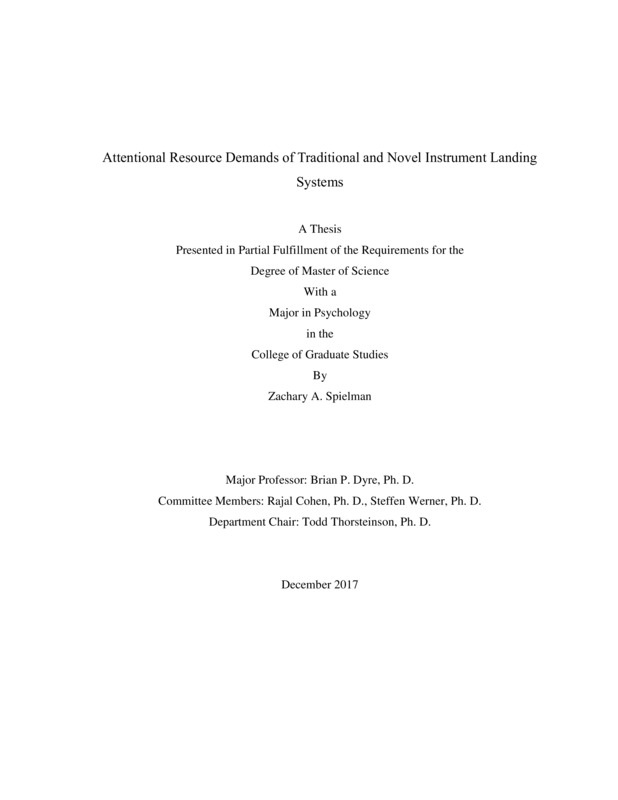Attentional Resource Demands of Traditional and Novel Instrument Landing Systems
Spielman, Zachary. (2017-12). Attentional Resource Demands of Traditional and Novel Instrument Landing Systems. Theses and Dissertations Collection, University of Idaho Library Digital Collections. https://www.lib.uidaho.edu/digital/etd/items/spielman_idaho_0089n_11266.html
- Title:
- Attentional Resource Demands of Traditional and Novel Instrument Landing Systems
- Author:
- Spielman, Zachary
- Date:
- 2017-12
- Program:
- Psychology
- Subject Category:
- Psychology
- Abstract:
-
A peripherally-located optical flow (POF) instrument landing system (ILS) display affords greater flight performance and sensitivity to a concurrent visual signal detection task, as compared to the display specified by Mil-Std 1787B. This study examined whether such an advantage extends to auditory secondary tasks. During a simulated approach and landing task participants maneuvered an aircraft along a predetermined glide path using either a peripherally-located optical flow instrument landing system or the Mil-Std 1787B landing system. Participants concurrently performed a visual or auditory signal detection task. Participant flight performance and signal detection task sensitivity were measures of the task time-sharing efficiency afforded by the ILS display. The visual task required participants to monitor two engines and identify the simultaneous occurrence of two critical conditions. The auditory task required participants to detect the sequential presentation of an assigned call sign and command line during a stream of call signs and command lines. Sensitivity in visual and auditory monitoring was assessed using the signal detection parameter A, while glide-path deviations served as the measure of landing performance. The mean performance of the flight control task by instrument landing display type matched performance patterns from previous studies. Visual signal detection performance improved while using the POF ILS for the flight task, suggesting a lower visual resource demand in comparison to the Mil-Std ILS. Display type did not affect auditory signal detection task performance. Since the auditory task is similarly affected by both displays in the flight control task but the visual task is more impacted by the Mil-Std display, we conclude the POF ILS imposes a central resource demand like the Mil-Std display but without the same visual processing demands.
- Description:
- masters, M.S., Psychology -- University of Idaho - College of Graduate Studies, 2017-12
- Major Professor:
- Dyre, Brian P
- Committee:
- Cohen, Rajal; Werner, Steffen
- Defense Date:
- 2017-12
- Identifier:
- Spielman_idaho_0089N_11266
- Type:
- Text
- Format Original:
- Format:
- application/pdf
- Rights:
- In Copyright - Educational Use Permitted. For more information, please contact University of Idaho Library Special Collections and Archives Department at libspec@uidaho.edu.
- Standardized Rights:
- http://rightsstatements.org/vocab/InC-EDU/1.0/

